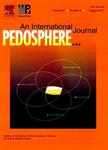Soil Bulk Density Estimation Methods: A Review
Soil Bulk Density Estimation Methods: A Review作者机构:School of Engineering Deakin University Soil Science and Water Resources Departments College of Agriculture University of Wasit Institute for Frontier Materials Deakin University
出 版 物:《Pedosphere》 (土壤圈(英文版))
年 卷 期:2018年第28卷第4期
页 面:581-596页
核心收录:
学科分类:09[农学] 0903[农学-农业资源与环境] 090301[农学-土壤学]
基 金:the Government and Ministry of Higher Education and Scientific Research Iraq for providing funding for this study as a scholarship for Ph.D. student for the first author Ahmed Abed Gatea Al-Shammary
主 题:measurement accuracy direct measurement methods gamma radiation indirect measurement methods regression methods sampling depth soil properties
摘 要:Measurement of soil bulk density is important for understanding the physical, chemical, and biological properties of soil. Accurate and rapid soil bulk density measurement techniques play a significant role in agricultural experimental research. This review is a comprehensive summary of existing measurement methods and evaluates their advantages, disadvantages, potential sources of error,and directions for future development. These techniques can be broadly categorised as direct and indirect methods. Direct methods include core, clod, and excavation sampling, whereas indirect methods include the radiation and regression approaches. The core method is most widely used, but it is time consuming and difficult to use for sampling multiple soil depths. The size of the coring cylinder used, operator experience, sampling depth, and in-situ soil moisture content significantly affect its accuracy. The clod method is suitable for use with heavy clay soils, and its accuracy is dependent on equipment calibration, drying time, and operator experience, but the process is complicated and time consuming. Excavation techniques are most commonly used to evaluate the bulk density of forest soils, but have major limitations as they cannot be used in soils with large pores and their measurement accuracy is strongly influenced by soil texture and the type of analysis selected. The indirect methods appear to have greater accuracy than direct approaches, but have higher costs, are more complex, and require greater operator experience. One such approach uses gamma radiation, and its accuracy is strongly influenced by soil depth. Regression methods are economical as they can make indirect measurements, but these depend on good, quality data of soil texture and organic matter content and geographical and climatic properties. Also, like most of the other approaches, its accuracy decreases with sampling depth.



